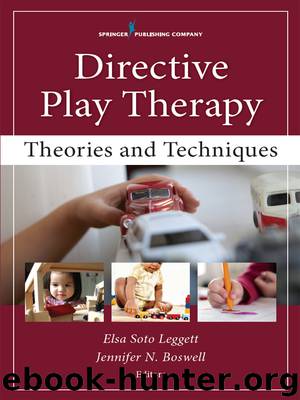Directive Play Therapy by Elsa Soto Leggett PhD LPC-S RPT-S Jennifer N. Boswell PhD LPC-S NCC RPT

Author:Elsa Soto Leggett, PhD, LPC-S, RPT-S,Jennifer N. Boswell, PhD, LPC-S, NCC, RPT
Language: eng
Format: epub
Publisher: Springer Publishing Company, Inc.
Published: 2016-10-25T04:00:00+00:00
Principles and Theories Underlying CPRT
The foundation of filial therapy rests on attachment theory (Bratton et al., 2015). Described as empathic, calm, and consistent, the presence of an emotionally responsive caregiver significantly impacts not only children’s social and emotional development (Sunderland, 2006), but also their executive functioning (Bernier, Beauchamp, Carlson, & Lalonde, 2015). Because of their primary attachment role, parents are a more powerful influence on children’s development than therapists (Guerney, 1964; VanFleet, 2013). Filial therapy is based on the assumption that a secure parent–child relationship is vital for children’s optimal health, so it focuses on bolstering this relationship through the transfer of CCPT skills from therapist to parent.
Although it is understood that parental stress can inhibit their ability to provide an environment supportive of children’s growth, the founders of filial therapy adopted the position that child problems result from lack of parental skill and knowledge (Guerney, 2000). CPRT also believes that parents have the capacity to learn the skills needed to build a secure parent–child relationship and that once they have done so, children’s maladaptive behaviors will self-correct (Bratton et al., 2015). This positive attribution to parents beckons them to become involved in the healing process and empowers them to grow and change.
Philosophies originating from Rogers’ (1951) person-centered and Axline’s (1969) CCPT approaches permeate filial therapy. Rooted in Rogers’ (1951) formative tendency, both CCPT (Axline, 1969) and CPRT (Landreth & Bratton, 2006) espouse that children’s behavior is always growth directed and will self-correct in the context of a secure relationship. Similarly, Rogers’ phenomenological approach is reflected in CPRT’s emphasis on understanding the child’s world from his or her perspective. CPRT implores parents to “look through the child’s eyes” (Landreth & Bratton, 2006, p. 4) to enhance understanding of and connection with the child. As filial therapy essentially teaches parents CCPT skills, the influence of CCPT is readily apparent. More important than the technical skills associated with CCPT is the parents’ fundamental presence. The “Be-With” attitudes (I am here, I hear you, I understand, and I care) communicate respect and treasuring of children (Landreth, 2002), and this rare and coveted engagement forms the foundation for the healing process. During the playtimes, parents focus only on the child and his or her experiences, not on their problems or fixing them.
Finally, CPRT acknowledges the significance of play in children’s development. Landreth’s (2002, p. 27) oft-quoted phrase, “Birds fly. Fish swim. Children play” illustrates the essential nature of play in children’s lives. In fact, Landreth (2002) asserts that “the natural medium of communication for children is play and activity,” (p. 9) and CPRT enables parents to connect with children in developmentally appropriate ways through play. Because children are not able to use abstract reasoning until around age 11 years (Piaget, 1962), efforts to bond with them through verbal expression before this age prove ineffective. Instead, adults must crawl into the concrete world of children’s play (Landreth, 2002; Piaget, 1962). Although parents are taught to honor the symbolic significance of their children’s play, the interpretation
Download
This site does not store any files on its server. We only index and link to content provided by other sites. Please contact the content providers to delete copyright contents if any and email us, we'll remove relevant links or contents immediately.
| Administration & Medicine Economics | Allied Health Professions |
| Basic Sciences | Dentistry |
| History | Medical Informatics |
| Medicine | Nursing |
| Pharmacology | Psychology |
| Research | Veterinary Medicine |
Periodization Training for Sports by Tudor Bompa(7922)
Why We Sleep: Unlocking the Power of Sleep and Dreams by Matthew Walker(6357)
Paper Towns by Green John(4800)
The Immortal Life of Henrietta Lacks by Rebecca Skloot(4257)
The Sports Rules Book by Human Kinetics(4078)
Dynamic Alignment Through Imagery by Eric Franklin(3920)
ACSM's Complete Guide to Fitness & Health by ACSM(3825)
Kaplan MCAT Organic Chemistry Review: Created for MCAT 2015 (Kaplan Test Prep) by Kaplan(3801)
Introduction to Kinesiology by Shirl J. Hoffman(3626)
Livewired by David Eagleman(3534)
The River of Consciousness by Oliver Sacks(3418)
The Death of the Heart by Elizabeth Bowen(3341)
Alchemy and Alchemists by C. J. S. Thompson(3295)
Descartes' Error by Antonio Damasio(3166)
Bad Pharma by Ben Goldacre(3097)
The Emperor of All Maladies: A Biography of Cancer by Siddhartha Mukherjee(2930)
The Gene: An Intimate History by Siddhartha Mukherjee(2927)
The Fate of Rome: Climate, Disease, and the End of an Empire (The Princeton History of the Ancient World) by Kyle Harper(2874)
Kaplan MCAT Behavioral Sciences Review: Created for MCAT 2015 (Kaplan Test Prep) by Kaplan(2815)
